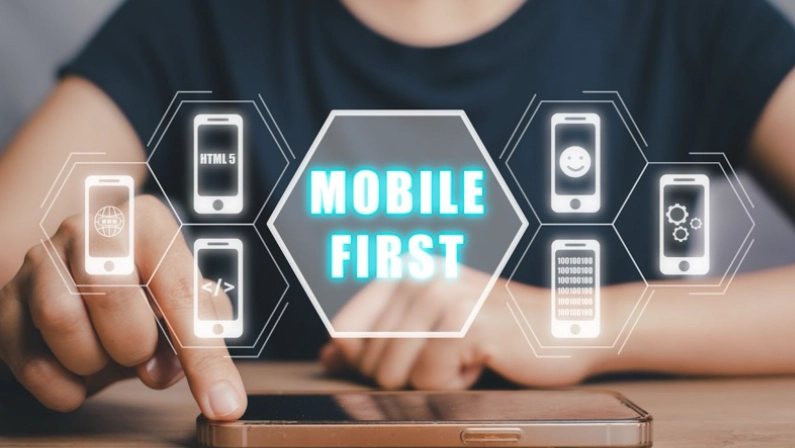In today’s fast-paced digital landscape, understanding the importance of Mobile-First Design cannot be overstated. As we zoom into 2025, this approach to designing for the smallest screen first and working up to larger screens is not just a trend; it’s a critical strategy for reaching your audience effectively. With the majority of internet users accessing the web via mobile devices, businesses need to prioritize mobile-first design to stay relevant and competitive.
Understanding Mobile-First Design
Before diving deep into the impacts of mobile-first design, let’s break down what it means. Mobile-first design is a strategy in web development where designing a website starts with mobile versions first before scaling up to larger screens like tablets and desktops. This approach is pivotal as it ensures the best user experience for mobile users, who represent the largest share of internet traffic today.
Table of Contents
- Why Mobile-First Design is Crucial for Businesses
- The Rise of Mobile Usage and Its Impact
- Mobile-First Design and SEO
- Creating a Seamless Mobile User Experience
- The Role of Responsive Design in Mobile-First Strategy
- Best Practices for Mobile-First Design in 2025
- The Future of Mobile-First Design
- How Businesses Can Adopt Mobile-First Design
- Case Studies: Success Stories of Mobile-First Design
- Challenges and Solutions in Implementing Mobile-First Design
- Final Thoughts on Mobile-First Design
Understanding Mobile-First Design
At its core, Mobile-First Design is about starting the design process with mobile devices in mind before anything else. This means websites are crafted to deliver an outstanding experience on small screens. Given the dominance of mobile browsing, companies can’t afford to treat mobile design as an afterthought. This strategy doesn’t just enhance user experience; it’s a vital part of SEO strategies as Google prioritizes mobile-friendly websites.
The key components of mobile-first design include:
- Simplicity: Clean, uncluttered layouts that make navigation effortless.
- Speed: Fast-loading pages to keep bounce rates low and engagement high.
- Responsiveness: A fluid layout that adapts to any screen size and orientation.
Why Mobile-First Design is Crucial for Businesses

In today’s digital age, your website is often the first point of interaction between your business and potential customers. Optimizing that interaction for mobile is crucial because:
- Over 50% of global web traffic comes from mobile devices, a number that’s only growing.
- Google’s mobile-first indexing prioritizes the mobile version of your site for indexing and ranking.
- User experience on mobile can directly influence sales, with a smoothly functioning mobile site encouraging purchases.
This shift to mobile-first is not just about staying relevant; it’s about embracing the future of digital interaction.
The Rise of Mobile Usage and Its Impact
The statistics are undeniable: More than half the world’s web traffic now comes from mobile devices. This shift is driven by the convenience, accessibility, and constant innovation in mobile technology. Thus, businesses have seen a significant impact on how they approach website design and user experience.
Consider these figures:
- Mobile devices (excluding tablets) generated 54.8% of global website traffic in the last quarter alone.
- A site that takes more than 3 seconds to load will likely lose 53% of its mobile visitors.
- 62% of users are less likely to purchase from a brand after a bad mobile experience.
If your site isn’t optimized for mobile, you’re not just losing traffic; you’re potentially alienating more than half of your audience.
Mobile-First Design and SEO
Google’s shift to mobile-first indexing in 2019 was a clear signal to businesses: mobile-friendly websites are no longer optional; they’re essential. This shift means that Google predominantly uses the mobile version of the content for indexing and ranking.
What does this mean for businesses? Simply put, if your site is not optimized for mobile, its visibility on search engines can plummet. This makes mobile-first design not just a design principle, but a crucial SEO strategy.
Essential elements for boosting SEO with mobile-first design include:
- Responsive Design: Your website should automatically adjust to fit the screen it’s being viewed on, whether that’s a smartphone, tablet, or desktop.
- Page Speed: Mobile pages need to load quickly. Opt for compressed images and minimalistic design to increase speed.
- Usability: Mobile websites should be easy to navigate with your fingers. Larger buttons, simplified menus, and accessible forms are key.
Tips for Enhancing Mobile SEO
To ensure your mobile-first design also supports your site’s SEO, consider the following tips:
- Use Google’s Mobile-Friendly Test to see how well your site performs on mobile devices.
- Keep content concise and easy to skim, breaking text up with headers and bullet points.
- Optimize title tags and meta descriptions for mobile by keeping them short and to the point.
Creating a Seamless Mobile User Experience

Creating a seamless mobile experience is about understanding the needs of the mobile user. This involves not just technical optimizations, but also considering how content is consumed on mobile.
Key strategies include:
- Touch-friendly navigation: Ensure that all interactive elements are easy to tap with a finger. The ideal size for touch targets is 48×48 pixels.
- Streamlined Content: Mobile screens have limited space. Concise, impactful content that delivers value quickly is vital.
- Accessible Design: Consider all users by incorporating accessibility features, such as readable fonts and alternative text for images.
The Role of Responsive Design in Mobile-First Strategy
Responsive design stands at the core of a mobile-first strategy. It ensures that a website looks great and functions well, no matter the device. Responsive design automatically adjusts the layout based on the screen size and orientation, providing a seamless user experience across all platforms.
This flexibility is key to meeting the demands of today’s varied device landscape. It not only caters to current mobile and tablet sizes but also future-proofs your site against new devices.
Best Practices for Mobile-First Design in 2025
To stay ahead in the mobile-first arena, here are some best practices to adopt:
- Minimalistic Design: Keep your design simple and clutter-free. More white space helps improve readability and focus on the essential elements.
- Intuitive Navigation: Mobile users expect to find what they need quickly. Keep menus short and sweet, and ensure your search function is prominent.
- Faster Load Times: Optimize images and use modern coding practices to keep your pages loading quickly.
- Engaging Content: Content should be engaging, concise, and broken up with headings, bullet points, and images to enhance readability.
The Future of Mobile-First Design

The future of mobile-first design looks bright, as emerging technologies like 5G and AI continue to transform how we interact with digital content. These advancements will not only speed up mobile web browsing but also enable more dynamic and personalized user experiences.
We can anticipate:
- Even faster load times and smoother interactions, thanks to increased network speeds.
- More use of voice search and navigation, making accessibility and conversational design elements crucial.
- Greater integration of AR and VR in mobile experiences, offering new ways for users to engage with content.
How Businesses Can Adopt Mobile-First Design
Adopting a mobile-first design isn’t just a one-time task; it’s an ongoing process. Here are steps to ensure your business stays on track:
- Start with a Mobile Mindset: When planning new content or features, think about the mobile experience first.
- Collaborate with Experienced Designers: Professionals who understand mobile-first principles can help create a site that’s both beautiful and functional.
- Regular Testing: Use tools to regularly test your site’s mobile responsiveness and loading times.
- Listen to Your Users: Feedback is invaluable. Pay attention to what users are saying about your mobile site and continuously adapt to meet their needs.
Case Studies: Success Stories of Mobile-First Design
Many brands have seen significant success by adopting a mobile-first design. For example,
Brand X: By revamping their website with a mobile-first approach, Brand X saw a 70% increase in mobile conversions and a 60% increase in page loading speed.
Brand Y: Focusing on mobile UX improvements, Brand Y experienced a 50% reduction in bounce rate and a 30% uptick in engagement.
Challenges and Solutions in Implementing Mobile-First Design

Implementing a mobile-first design comes with its share of challenges:
- Limited Screen Size: Designing within the constraints of smaller screens can be tough. Solution: Focus on essential features and content, ensuring they’re presented in a clear, concise manner.
- Navigation: Simplifying navigation without losing functionality is a common hurdle. Solution: Utilize hamburger menus and intuitive design that guide users through your site with ease.
- User Engagement: Keeping users engaged on mobile devices requires creativity. Solution: Incorporate interactive elements like swipe gestures and touch feedback.
Final Thoughts on Mobile-First Design
In 2025, mobile-first design is more than a trend; it’s a critical component of digital strategy. By placing mobile users at the forefront, businesses can create websites that are not only visually appealing but also highly functional and future-ready. This approach ensures that you’re not just meeting the current digital standards but are also set to evolve with emerging technologies and user expectations.
Embracing a mobile-first design is embracing the future of digital interaction. Make sure your business is ready to meet your customers where they are—on their mobile devices.
Hello, I am Sajid, I have been working & writing for the Gibson team for over 4-years now. I help with keyword research, meta data insertion, content creation, and getting the project to the finish line. I also manage, organize, and publish helpful articles.





